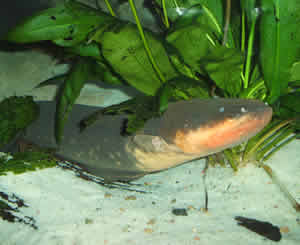
Research reveals 6 different electric fish lineages evolved by using the same electricity-producing 'tool box'. credit Steven Johnson.
New research demonstrates that the six electric fish lineages, all of which evolved independently, used essentially the same genes and developmental and cellular pathways to make an electricity-generating organ for defense, predation, navigation and communication.
The work will be published June 27 in the journal Science. The research was led by Michael Sussman of The University of Wisconsin-Madison, Harold Zakon of The University of Texas at Austin and Manoj Samanta of the Systemix Institute in Redmond, Wash.
Fish evolved an electric organ independently half a dozen times in environments ranging from the flooded forests of the Amazon to murky marine environments. Charles Darwin himself cited electric fish as prime examples of convergent evolution, where unrelated animals independently evolve similar traits to adapt to a particular environment or ecological niche.
"The surprising result of our study is that electric fish seem to use the same 'genetic toolbox' to build their electric organ," despite the fact that they evolved independently, says Jason Gallant, an assistant professor at Michigan State University and co-lead author of the study.
To reach their conclusions, the researchers assembled the complete genome of the most potent electric fish, the electric eel, and the genetic sequences involved in constructing electric organs and skeletal muscles from three fish lineages that have independently evolved electric organs.
Zakon, professor of biology and neuroscience in The University of Texas at Austin's College of Natural Sciences, identified some of the genes that, depending on how they are regulated, can turn simple muscle tissue into an electric organ. Zakon and Gallant also identified some of the key molecular pathways used by multiple electric fish lineages to converge on similar electric organs
"An exciting result of this work is that it pinpoints steps in various cellular pathways that are the most likely to evolve in other animals as well," says Zakon. "For example, the pathways that transmit electrical pulses in the vertebrate heart, including our own heart, derive from muscles. We find that electric organs in fish and these pathways in our hearts share some of the same regulatory genes."
The electric organ is used by fish in murky environments to communicate with mates, navigate, stun prey and as a shocking defense, probably a reason the muddy Amazon and its tributaries teem with electric fish, including the electric eel. Not really an eel but a fish more closely related to the catfish, the electric eel produces a jolting electric field of up to 600 volts, about 100 volts per foot of fish.
All muscle cells have electrical potential. Simple contraction of a muscle will release a small amount of current. But at least 100 million years ago some fish began to amplify that potential by evolving from muscle cells another type of cell called an electrocyte, larger cells organized in sequence and capable of generating much higher voltages than those used to make muscles work.
The "in-series" alignment of the electrocytes and unique polarity of each cell allow for the "summation of voltages, much like batteries stacked in series in a flashlight," says Sussman. An electric eel body contains many millions of such "flashlights" working together and firing their electrical discharge simultaneously
"Our study demonstrates nature's creative powers and its parsimony, using the same genetic and developmental tools to invent an adaptive trait time and again in widely disparate environments," says Susmann, a professor of biochemistry and director of the UW-Madison Biotechnology Center, who first undertook the exploration of the electric organ almost a decade ago. "By learning how nature does this, we may be able to manipulate the process with muscle in other organisms, and in the near future, perhaps use the tools of synthetic biology to create electrocytes for generating electrical power in bionic devices within the human body or for uses we have not thought of yet."
The study was funded by the National Science Foundation, the W.M. Keck Foundation and the National Institutes of Health.
